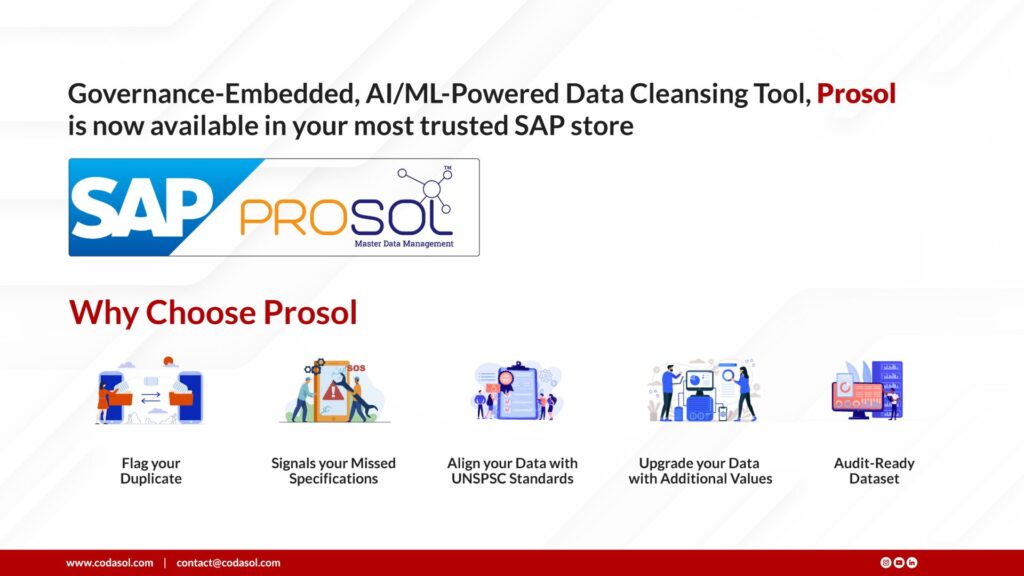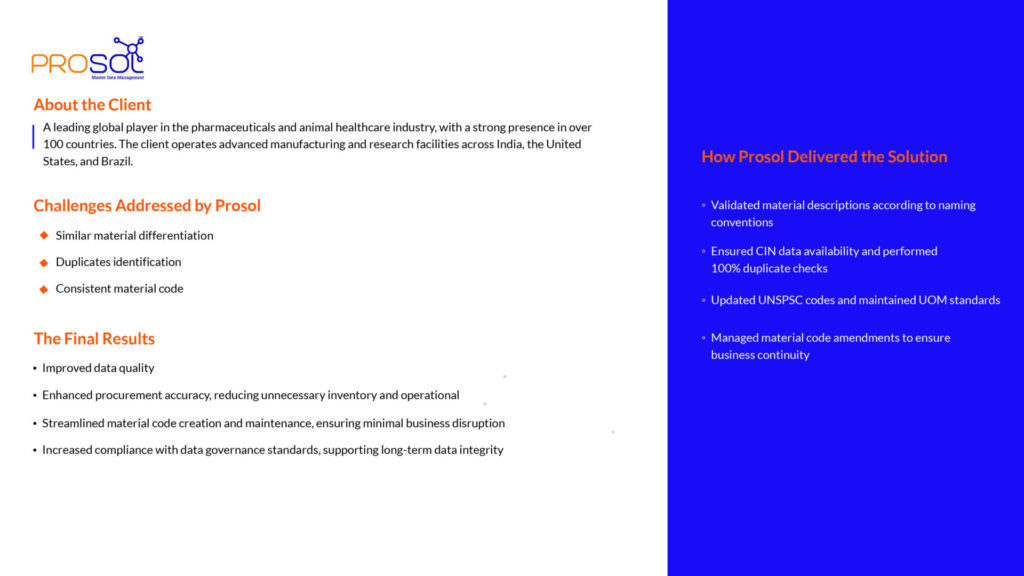PROSOL ERP integration: Why PROSOL and Swift Work Better with Maximo, Oracle, and SAP
Bad master data is a silent profit leak. When ERPs or EAMs, like SAP, Oracle, or Maximo, hold duplicate parts, inconsistent specs, or manually created descriptions, the result is slow maintenance, procurement waste, and operational blind spots. PROSOL and Swift ERP integration closes that gap by delivering governed, standardized, and upload-ready master data directly into your enterprise systems, with speed and precision.
Summary
If your organization wants predictable ERP rollouts, fewer procurement errors, and faster maintenance cycles, the winning move is to ensure governance before data hits SAP, Oracle, or Maximo. PROSOL ERP integration combines AI-driven deduplication, ISO/UNSPSC standardization, and plug-and-play ERP connectors to deliver clean, approved material masters directly into your production environment.

Why integration quality matters more than ever
Enterprises in asset-heavy sectors have learned this the hard way:
- Duplicate codes inflate inventory and distort reorder planning.
- Manual validation cycles stretch ERP rollouts for months.
- Bad data surfaces in maintenance delays, unplanned downtime, and expensive emergency buys.
- Multi-plant operations struggle with inconsistent naming, incomplete specs, and mismatched units of measure.
A strong MDM → ERP/EAM integration layer eliminates these issues by enforcing accuracy, approvals, and consistency before data reaches your operational systems.

Experience PROSOL’s SAP/Oracle/Maximo Integrators in action
How Coda’s PROSOL and Swift achieve better ERP integration
- AI-driven deduplication and pattern detection
Swift uses deep-learning models (LSTM, BERT) to identify near-duplicates by analyzing specifications, attributes, and contextual language patterns, not just descriptions. That means it can unify variants like “pump 2-inch SS316” and “SS316 pump dia 2 inch” with precision.
- Standards-first, not cleanup-first
PROSOL enforces UNSPSC and ISO 8000 from the moment data is captured. Once templates and rules are active, new material requests follow a uniform structure, so future work orders stop inheriting the sins of the past.
- Role-based approvals and governance baked in
Maintenance, procurement, and engineering teams approve and validate data through structured workflows. PROSOL ensures only approved, standardized, complete masters reach ERP systems.
- Plug-and-play ERP and EAM connectors
These connectors reduce the middleware burden that typically slows down ERP go-lives. PROSOL supports direct preparation and upload readiness for SAP, Oracle, and Maximo, complete with audit trails that streamline compliance.
- SAP Store availability
Since PROSOL is listed on the SAP Store, enterprises get the advantage of SAP-reviewed compatibility and smoother integration during implementation.
SAP vs. Oracle vs. Maximo — How PROSOL integrates differently
| Area | SAP | Oracle | IBM Maximo |
|---|---|---|---|
| Typical master role | SAP MDG or external MDM | Oracle MDM or external MDM | Maximo holds asset/maintenance records |
| Best practice | Central master → PROSOL validation → SAP | Oracle master or MDM-assisted → PROSOL staging | Define master for parts → sync with Maximo |
| Connectivity | SAP connectors, IDocs, APIs | REST/SOAP + Oracle adapters | Maximo enterprise adapters |
| Common pitfalls | Material views mismatch | Mapping complexity | BOM vs Material master conflicts |
| Where PROSOL helps | Templates, standards, upload-ready masters | Real-time validation & spec matching | Pre-built EAM sync and ISO/UNSPSC enforcement |
7-step implementation blueprint for decision-makers
1. Define the “master of record” per domain
Whether it’s SAP MDG or PROSOL as the staging master, one must lead. Teams that avoid ambiguity see smoother global rollouts.
2. Prioritize high-value domains
Critical spare parts, equipment, and vendor masters deliver the fastest ROI.

3. Activate ISO/UNSPSC templates
Prevent future drift by enforcing structure at the point of data entry.
4. Use Swift AI for matching before human review
AI proposes consolidations; humans simply approve.
5. Use prebuilt ERP/EAM connectors
This eliminates custom scripting and reduces failure points.
6. Pilot → Measure → Scale
Track improvements in cycle time, duplicate reduction, and procurement error rates.
7. Train teams & embed governance
A system is only as strong as its adoption.
What this looks like in real numbers
A mid-size oil & gas operator cleaned 100,000+ material codes with Swift. Within six months:
- 65% reduction in duplicates
- 35% faster material creation cycle time
- 20% fewer expedited orders
- Extensive savings in carrying cost and maintenance planning time
These gains came from AI patterning, ISO enforcement, and direct ERP/EAM integration, not from a manual spreadsheet cleanup.
Security, compliance, and governance
PROSOL maintains version-controlled audit logs, role-based approvals, and complete traceability for every master data change. ISO 8000 enforcement during creation ensures compliance for industries working under safety, environmental, or regulatory scrutiny (energy, utilities, chemicals, defence).
Common integration pitfalls PROSOL Eliminates
- The trap of manual mapping
Teams often spend weeks stitching together legacy descriptions, inconsistent attributes, and plant-level variations. PROSOL removes that drag. Its AI-driven matching engine and standardized templates automate the bulk of the work, so your experts validate instead of manually rebuilding data.
- Middleware sprawl that slows every rollout
Complex ERP/EAM landscapes often rely on layers of connectors, scripts, and interfaces. PROSOL streamlines that architecture with native, purpose-built integrations for SAP, Oracle, and Maximo, drastically reducing custom development and long-term maintenance effort.
- Governance breakdown after go-live
Most organizations clean their data once, only to watch it decay again. PROSOL locks governance into the creation process. Every new record passes through approval workflows, rules, and standardized templates, preventing drift and keeping your ERP data consistently accurate.

Final recommendation for decision-makers ready to move
If you are planning an ERP upgrade, EAM migration, or full-scale data governance transformation, prioritize platforms that ensure integration accuracy with minimal technical burden. PROSOL ERP integration stands out because it blends:
- AI-backed cleansing
- Standards-based governance
- SAP Store-verified compatibility
- Rapid integration with SAP, Oracle, and Maximo
Together, these capabilities reduce rollout risk and unlock fast, measurable operational value.
Get a tailored integration assessment and pilot plan

Frequently Asked Questions
1. Should PROSOL or the ERP serve as the material master?
Choose a single master per domain. Many enterprises use PROSOL as the governance layer before creation in SAP or Oracle, while SAP MDG-led organizations use PROSOL as an enrichment and validation engine.
2. How long does a PROSOL Swift cleanup take?
Most pilots run in weeks, not months, thanks to AI-driven deduplication and preconfigured templates.
3. Does PROSOL require heavy middleware?
No. Its prebuilt SAP, Oracle, and Maximo connectors minimize custom development.
4. Does PROSOL support industry cataloging standards?
Yes, UNSPSC and ISO 8000 are embedded into its validation and approval workflows.
5. What KPIs should be tracked?
Duplicate rate, creation cycle time, emergency buys, procurement accuracy, and audit exceptions.

